A Context-Aware Android Malware Detection Approach Using Machine Learning
Abstract
1. Introduction
- The paper created a new dataset of static API Calls and permissions features from a large number of Android APKs.
- The paper selected and used the most relevant contextual features along with the API Calls and permissions to test the efficacy of using contextual information in detecting Android malware.
- The proposed model used the Information Gain algorithm [17] to reduce the feature space from 527 API Calls and permissions to 50 features only and achieve a very close accuracy to what was achieved using 527 features.
- The paper tested several machine learning algorithms, which are Random Forest, Logistic Regression, SVM, K-NN, and Decision Trees using different combinations of API Calls, permissions, and contextual features to evaluate their accuracy in detecting Android malware.
- The experiments show that using the selected contextual features, the proposed model achieved a high accuracy of about 99.4% in detecting Android malware.
- The paper considers different state-of-the art models that used contextual features or the same dataset used in this work, and it shows that the proposed models outperformed the state-of-the art models.
2. Related Work
3. Methodology
3.1. Datasets
3.2. Features Extraction
3.2.1. API Calls Features
3.2.2. Permissions Features
3.2.3. Contextual Features Extraction
3.3. Features Processing
3.4. Feature Extraction and Selection
3.5. Machine Learning Algorithms
3.5.1. Random Forest RF
3.5.2. Support Vector Machines SVM
3.5.3. Logistic Regression LR
3.5.4. Naïve Bayesian NB
3.5.5. K-Nearest Neighbor KNN
3.5.6. Decision Trees DT
4. Experiments and Results
4.1. Results and Analysis
- TP (True Positive) is the number of malware detections that are correctly labeled as malware,
- TN (True Negative) is the number at which benign is accurately identified as benign,
- FP (False Positive) is the number of benign that are mistakenly identified as malware, and
- FN (False Negative) is the number at which malware is incorrectly identified as benign.
4.1.1. API Calls-Based Android Malware Detection
4.1.2. Permissions-Based Android Malware Detection
4.1.3. API Calls and Permissions-Based Android Malware Detection
4.1.4. API Calls and Permissions-Based Android Malware Detection with Feature Selection
4.1.5. API Calls and Permissions with Feature Selection and Contextual Information-Based Android Malware Detection
4.2. Results Summary
4.3. State of Art
5. Conclusions
Author Contributions
Funding
Data Availability Statement
Conflicts of Interest
References
- Singh, R. An Overview of Android Operating System and Its Security Features. J. Eng. Res. Appl. 2014, 4, 519–521. [Google Scholar]
- Mobile Security Review 2021—AV-Comparatives. Available online: https://www.av-comparatives.org/tests/mobile-security-review-2021/#google-android (accessed on 9 September 2022).
- Singh, P.; Tiwari, P.; Singh, S. Analysis of Malicious Behavior of Android Apps. Procedia Comput. Sci. 2016, 79, 215–220. [Google Scholar] [CrossRef]
- 2021 Mobile Malware Evolution: Fewer Attacks, Escalating Dangers. Available online: https://www.techrepublic.com/article/2021-mobile-malware-evolution-fewer-attacks-escalating-dangers/ (accessed on 9 September 2022).
- Sk, H.K. A Literature Review on Android Mobile Malware Detection using Machine Learning Techniques. In Proceedings of the 6th International Conference on Computing Methodologies and Communication (ICCMC), Erode, India, 29–31 March 2022; pp. 986–991. [Google Scholar] [CrossRef]
- Salah, Y.; Hamed, I.; Nabil, S.; Abdulkader, A.; Mostafa, M. Mobile Malware Detection: A Survey. Int. J. Comput. Sci. Inf. Secur. 2019, 17, 56–65. [Google Scholar]
- Moses, A.; Morris, S. Analysis of Mobile Malware: A Systematic Review of Evolution and Infection Strategies. J. Inf. Secur. Cybercrimes Res. 2021, 4, 103–131. [Google Scholar] [CrossRef]
- Kambar, M.E.; Esmaeilzadeh, A.; Kim, Y.; Taghva, K. A Survey on Mobile Malware Detection Methods using Machine Learning. In Proceedings of the IEEE 12th Annual Computing and Communication Workshop and Conference (CCWC), Las Vegas, NV, USA, 26–29 January 2022; pp. 0215–0221. [Google Scholar] [CrossRef]
- Yerima, S.Y.; Alzaylaee, M.K. Mobile Botnet Detection: A Deep Learning Approach Using Convolutional Neural Networks. arXiv 2020, arXiv:2007.00263. [Google Scholar]
- Alzaylaee, M.K.; Yerima, S.Y.; Sezer, S. Dynalog: An automated dynamic analysis framework for characterizing android applications. In Proceedings of the International Conference On Cyber Security and Protection of Digital Services (Cyber Security), London, UK, 13–14 June 2016; pp. 1–8. [Google Scholar]
- Kosmidis, K.; Kalloniatis, C. Machine learning and images for malware detection and classification. ACM International Conference Proceeding Series. In Proceedings of the 21st Pan-Hellenic Conference on Informatics, Larissa, Greece, 28–30 September 2017. [Google Scholar]
- Chumachenko, K. Machine Learning Methods for Malware Detection and Classification. Bachelor’s Thesis, South-Eastern Finland University of Applied Sciences, Kouvola, Finland, 2017. [Google Scholar]
- Narayanan, A.; Chandramohan, M.; Chen, L.; Liu, Y. Context-Aware, Adaptive, and Scalable Android Malware Detection Through Online Learning. IEEE Trans. Emerg. Top. Comput. Intell. 2017, 1, 157–175. [Google Scholar] [CrossRef]
- Kapratwar, A.; Di Troia, F.; Stamp, M. Static and dynamic analysis of android malware. In Proceedings of the 3rd International Conference on Information Systems Security and Privacy, Porto, Portugal, 19–21 February 2017. [Google Scholar]
- Bhatia, T.; Kaushal, R. Malware detection in android based on dynamic analysis. In Proceedings of the 2017 International Conference on Cyber Security and Protection of Digital Services (Cyber Security), London, UK, 19–20 June 2017. [Google Scholar]
- Amamra, A.; Talhi, C.; Robert, J.M. Smartphone malware detection: From a survey towards taxonomy. In Proceedings of the 2012 7th International Conference on Malicious and Unwanted Software, Fajardo, PR, USA, 16–18 October 2012. [Google Scholar]
- Larose Daniel, T. Discovering Knowledge in Data: An Introduction to Data Mining; Wiley: Hoboken, NJ, USA, 2014; pp. 174–179. ISBN 9780470908747. [Google Scholar]
- Le, N.C.; Nguyen, T.M.; Truong, T.; Nguyen, N.D.; Ngo, T. A Machine Learning Approach for Real Time Android Malware Detection. In Proceedings of the 2020 RIVF International Conference on Computing and Communication Technologies (RIVF), Ho Chi Minh City, Vietnam, 14–15 October 2020. [Google Scholar]
- Virusshare. Available online: https://virusshare.com/ (accessed on 30 August 2022).
- Koodous: Collective Intelligence against Android Malware. Available online: https://koodous.com/ (accessed on 30 August 2022).
- Kavediya, V.; Sadashiv, M.; Mhaskar Kulkarni, K.; Prabhu, S.; Balbudhe, K. Android Malware Detection using Machine learning technique. Int. J. Res. Anal. Rev. 2020, 7, 777–780. [Google Scholar]
- Han, H.; Lim, S.; Suh, K.; Park, S.; Cho, S.J.; Park, M. Enhanced android malware detection: An SVM-based machine learning approach. In Proceedings of the 2020 IEEE International Conference on Big Data and Smart Computing (BigComp), Busan, Korea, 19–22 February 2020. [Google Scholar]
- Li, Y.; Jang, J.; Hu, X.; Ou, X. Android Malware Clustering through Malicious Payload Mining. In International Symposium on Research in Attacks, Intrusions, and Defenses; Springer: Cham, Switzerland, 2017. [Google Scholar]
- Arp, D.; Spreitzenbarth, M.; Hübner, M.; Gascon, H.; Rieck, K. DREBIN: Effective and Explainable Detection of Android Malware in Your Pocket. In Proceedings of the Symposium on Network and Distributed System Security (NDSS), San Diego, CA, USA, 23–26 February 2014. [Google Scholar]
- APKPure. Available online: https://m.apkpure.com/ (accessed on 30 August 2022).
- Mantoo, B.A.; Khurana, S.S. Static, Dynamic and Intrinsic Features Based Android Malware Detection Using Machine Learning. Lect. Notes Electr. Eng. 2020, 597, 31–45. [Google Scholar]
- Kang, H.J.; Jang, J.W.; Mohaisen, A.; Kim, H.K. AndroTracker: Creator Information based Android Malware Classification System. In Proceedings of the 15th International Workshop in Information Security Applications, Jeju Island, Korea, 25–27 August 2014. [Google Scholar]
- Google Paly Store. Available online: https://play.google.com/store/apps (accessed on 30 August 2022).
- Fang, Y.; Gao, Y.; Jing, F.; Zhang, L. Android Malware Familial Classification Based on DEX File Section Features. IEEE Access 2020, 8, 10614–10627. [Google Scholar] [CrossRef]
- Vasan, D.; Alazab, M.; Wassan, S.; Naeem, H.; Safaei, B.; Zheng, Q. IMCFN: Image-based malware classification using fine-tuned convolutional neural network architecture. Comput. Netw. 2020, 171, 107–138. [Google Scholar] [CrossRef]
- Nataraj, L.; Karthikeyan, S.; Jacob, G.; Manjunath, B. Malware images: Visualization and automatic classification. In Proceedings of the 8th International Symposium on Visualization for Cyber Security, Pittsburgh, PA, USA, 20 July 2011. [Google Scholar]
- Ünver, H.M.; Bakour, K. Android malware detection based on image-based features and machine learning techniques. SN Appl. Sci. 2020, 2, pp. 1–15. [Google Scholar] [CrossRef]
- Nasri, N.; Razak, M.A. Android Malware Detection System using Machine Learning. Int. J. Adv. Trends Comput. Sci. Eng. 2020, 9, 327–333. [Google Scholar] [CrossRef]
- Ali, W.; Abdulghafor, R.; Abdullah, T. Empirical Study on Intelligent Android Malware Detection based on Supervised Machine Learning. Int. J. Adv. Comput. Sci. Appl. 2020, 11, 215–224. [Google Scholar]
- Du, X.; Pan, X.; Cao, Y.; He, B.; Fang, G.; Chen, Y.; Xu, D. FlowCog: Context-aware Semantic Extraction and Analysis of Information Flow Leaks in Android Apps. In IEEE Transactions on Mobile Computing; IEEE: Piscataway, NJ, USA, 2022. [Google Scholar]
- Narayanan, A.; Chandramohan, M.; Chen, L.; Liu, Y. A multi-view context-aware approach to Android malware detection and malicious code localization. Empir. Softw. Engg. 2018, 23, 3. [Google Scholar] [CrossRef]
- Mahdavifar, S.; Kadir, A.; Fatemi, R.; Alhadidi, D.; Ghorbani, A. Dynamic Android Malware Category Classification using Semi-Supervised Deep Learning. In Proceedings of the IEEE International Conference on Dependable, Autonomic and Secure Computing, International Conference on Pervasive Intelligence and Computing, International Conference on Cloud and Big Data Computing, International Conference on Cyber Science and Technology Congress (DASC/PiCom/CBDCom/CyberSciTech), Calgary, AB, Canada, 17–22 August 2020. [Google Scholar]
- Hadiprakoso, R.B.; Kabetta, H.; Buana, I. Hybrid-Based Malware Analysis for Effective and Efficiency Android Malware Detection. In Proceedings of the 2nd International Conference on Informatics, Multimedia, Cyber, and Information System, ICIMCIS 2020, Jakarta, Indonesia, 19–20 November 2020. [Google Scholar]
- Mahdavifar, A.; Abdul Kadir, R.; Fatemi, D.; Alhadidi, A. Ghorbani, Dynamic Android Malware Category Classification using Semi-Supervised Deep Learning. In Proceedings of the 18th IEEE International Conference on Dependable, Autonomic, and Secure Computing (DASC), Calgary, AB, Canada, 17–24 August 2020. [Google Scholar]
- MalDroid 2020, Canadian Institute for Cybersecurity. Available online: https://www.unb.ca/cic/datasets/maldroid-2020.html (accessed on 9 September 2022).
- Karbab, E.; Debbabi, M.; Derhab, A.; Mouheb, D. MalDozer: Automatic framework for android malware detection using deep learning. Digit. Investig. 2018, 24, S48–S59. [Google Scholar] [CrossRef]
- VirusTotal. Available online: https://www.virustotal.com/ (accessed on 30 August 2022).
- Parkour, M. Contagio Mini-Dump. Available online: http://contagiominidump.blogspot.it/ (accessed on 30 August 2022).
- Saint Yen, Y.; Sun, H.M. An Android mutation malware detection based on deep learning using visualization of importance from codes. Microelectron. Reliab. 2019, 93, 109–114. [Google Scholar]
- Thomas, T.; Vijayaraghavan, A.P.; Emmanuel, S. Machine Learning Approaches in Cyber Security Analytics; Springer: Singapore, 2019; pp. 1–209. [Google Scholar]
- Welcome to Androguard’s Documentation! Androguard 3.4.0 Documentation. Available online: https://androguard.readthedocs.io/en/latest/ (accessed on 9 September 2022).
- GitHub-Androguard/Androguard: Reverse Engineering, Malware and Goodware Analysis of Android Applications… and More. Available online: https://github.com/androguard/androguard (accessed on 9 August 2022).
- Sharma, A.; Dash, S.K. Mining API Calls and Permissions for Android Malware Detection. Lect. Notes Comput. Sci. 2014, 8813, 191–205. [Google Scholar]
- Lei, S. A feature selection method based on information gain and genetic algorithm. In Proceedings of the 2012 International Conference on Computer Science and Electronics Engineering, Hangzhou, China, 23–25 March 2012. [Google Scholar]
- Ho, T.K. Random decision forests. In Proceedings of the 3rd International Conference on Document Analysis and Recognition, Montreal, QC, Canada, 14–16 August 1995. [Google Scholar]
- Pandey, S.; Lal, R. Opcode-Based Android Malware Detection Using Machine Learning Techniques. J. Innov. Eng. Techn. 2021, 5, 56–61. [Google Scholar]
- Mohamad Arif, J.; Razak, M.F.; Awang, S.; Tuan Mat, S.R.; Ismail, N.S.N.; Firdaus, A. A static analysis approach for Android permission-based malware detection systems. PLoS ONE 2021, 16, e0257968. [Google Scholar] [CrossRef]
- Singh, D.; Karpa, S.; Chawla, I. Emerging Trends in Computational Intelligence to Solve Real-World Problems’ Android Malware Detection Using Machine Learning. In International Conference on Innovative Computing and Communications; Springer: Singapore, 2022. [Google Scholar]
- Muzaffar, A.; Ragab Hassen, H.; Lones, M.A.; Zantout, H. Android Malware Detection Using API Calls: A Comparison of Feature Selection and Machine Learning Models. Lect. Notes Networks Syst. 2022, 378, 3–12. [Google Scholar]
- Cortes, C.; Vapnik, V.; Saitta, L. Support-vector networks. Mach. Learn. 1995, 20, 273–297. [Google Scholar] [CrossRef]
- Dutt, S.; Chandramouli, S.; Kumar Das, A. Machine Learning, 1st ed.; Pearson Education: Bengaluru, India, 2018. [Google Scholar]
- Agrawal, P.; Trivedi, B. Machine Learning Classifiers for Android Malware Detection. Adv. Intell. Syst. Comput. 2021, 1174, 311–322. [Google Scholar]
- Abu Alfeilat, H.A.; Hassanat, A.B.; Lasassmeh, O.; Tarawneh, A.S.; Alhasanat, M.B.; Eyal Salman, H.S.; Prasath, V.S. Effects of Distance Measure Choice on K-Nearest Neighbor Classifier Performance: A Review. J. Big Data 2019, 7, 221–248. [Google Scholar] [CrossRef] [PubMed]
- Zulkifli, A.; Hamid, I.R.A.; Shah, W.M.; Abdullah, Z. Android Malware Detection Based on Network Traffic Using Decision Tree Algorithm. Adv. Intell. Syst. Comput. 2018, 700, 485–494. [Google Scholar]
- Kouliaridis, V.; Kambourakis, G. A Comprehensive Survey on Machine Learning Techniques for Android Malware Detection. Information 2021, 12, 185. [Google Scholar] [CrossRef]
- Powers, D. Evaluation: From Precision, Recall and F-Factor to ROC, Informedness, Markedness & Correlation. Mach. Learn. Technol. 2008, 2, 37–63. [Google Scholar]
- Icc-Bench. Available online: https://github.com/fgwei/ICC-Bench (accessed on 15 September 2022).
- Malgenome Project. Available online: http://www.Malgenomeproject.org (accessed on 15 September 2022).
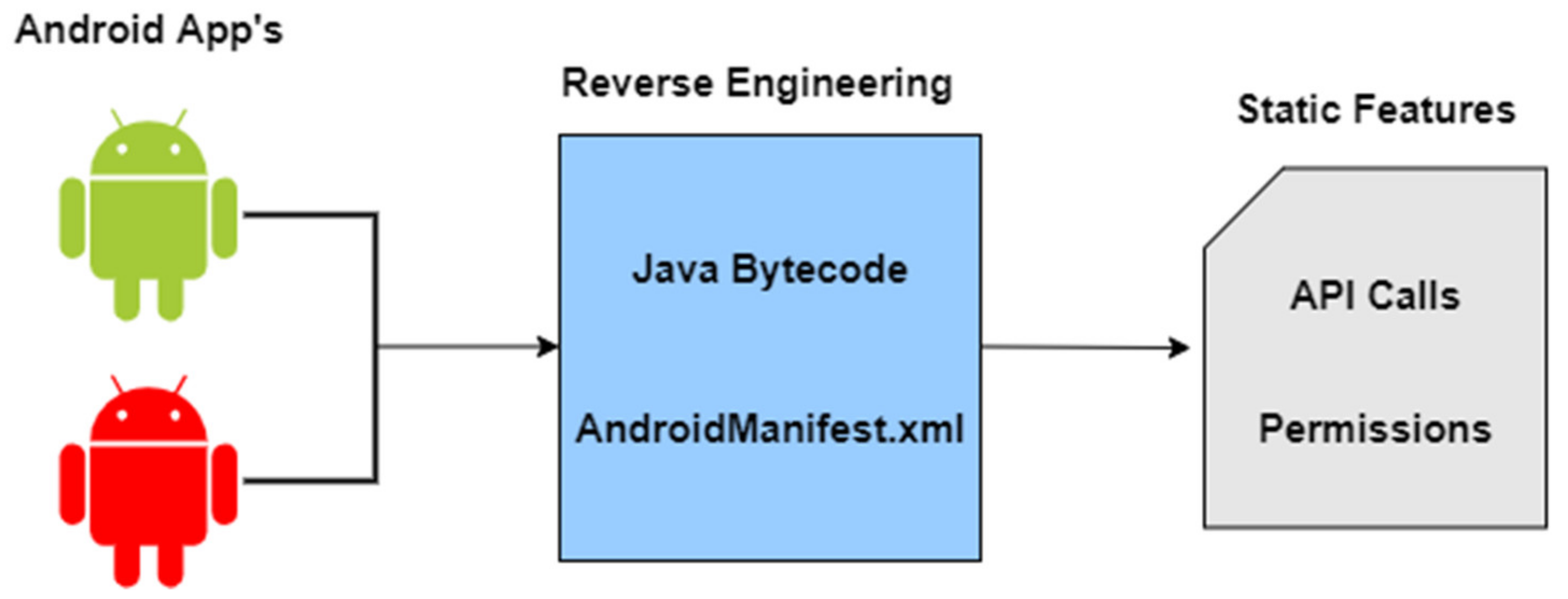
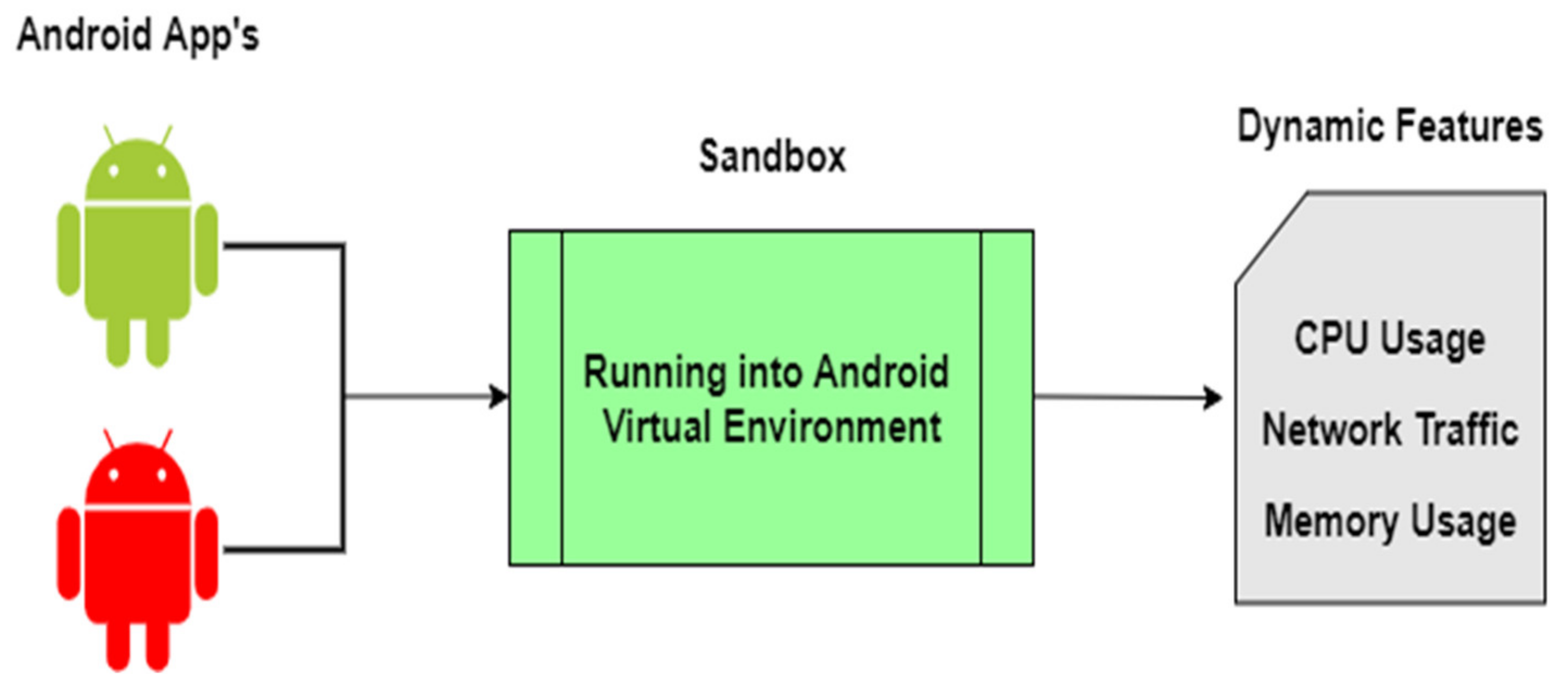
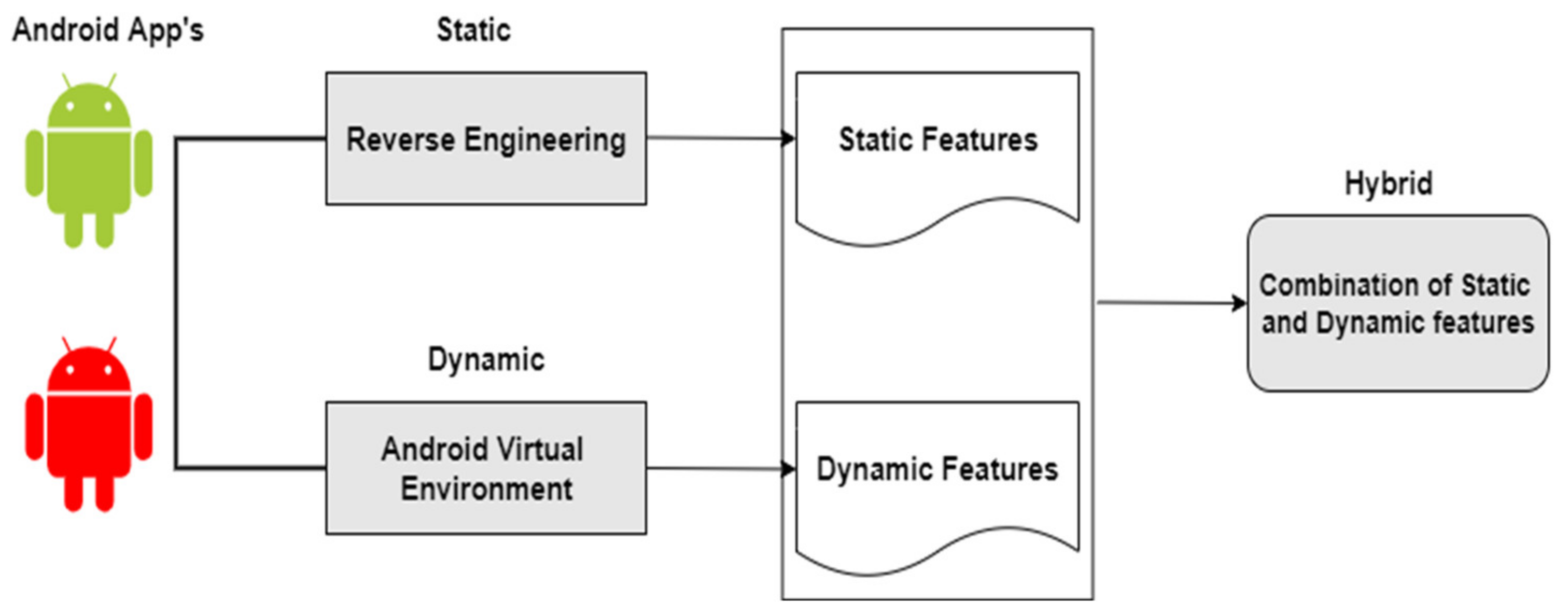
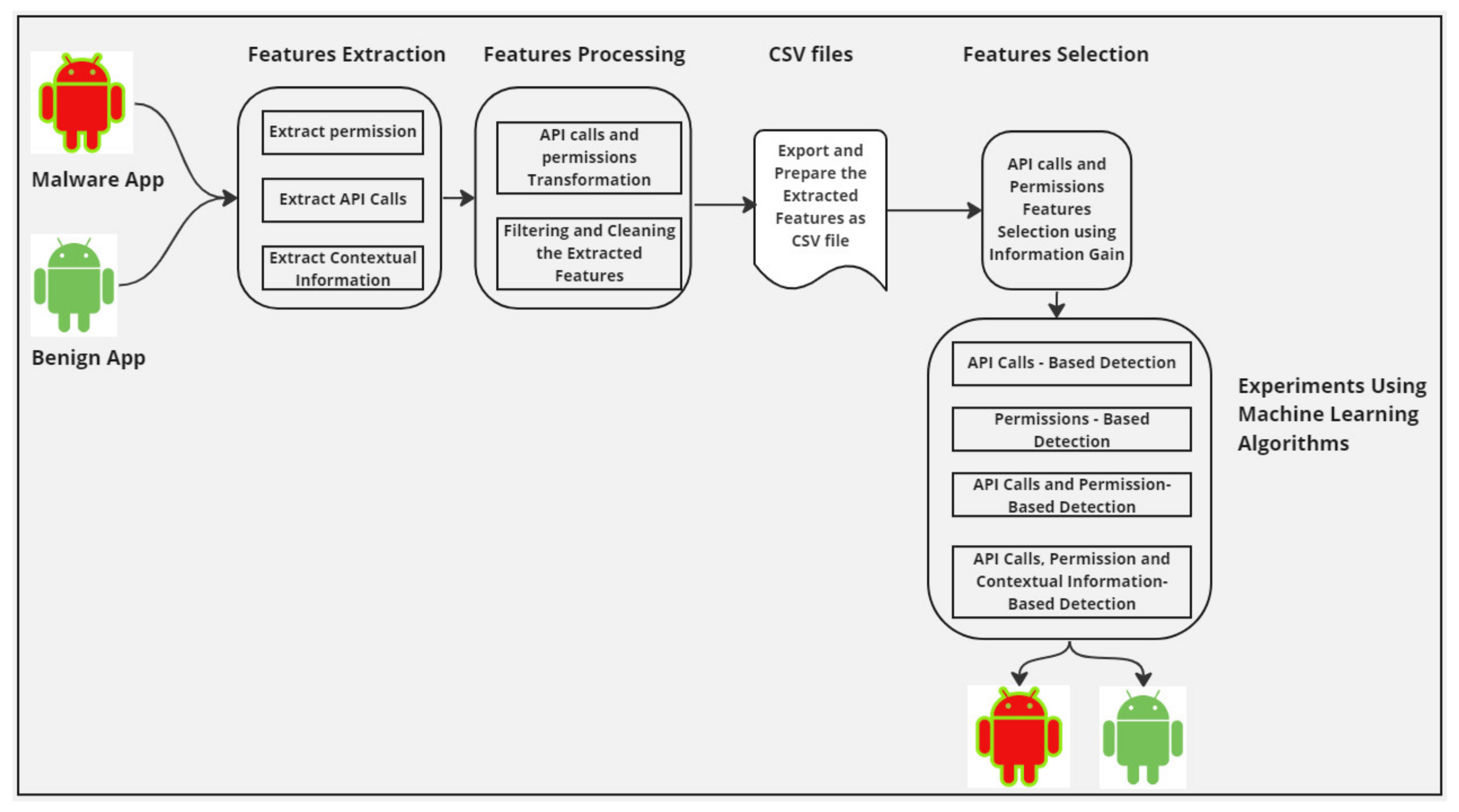
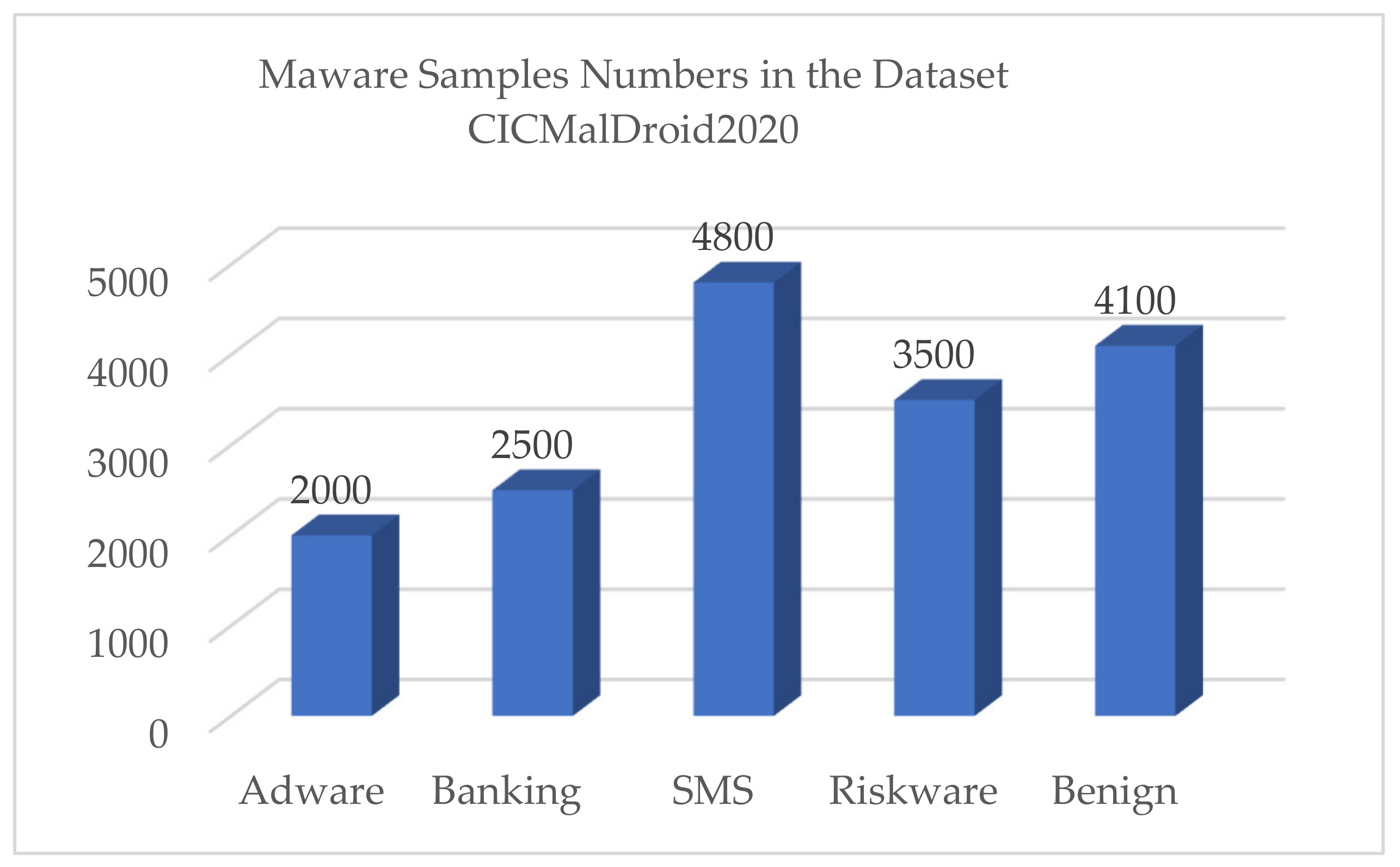
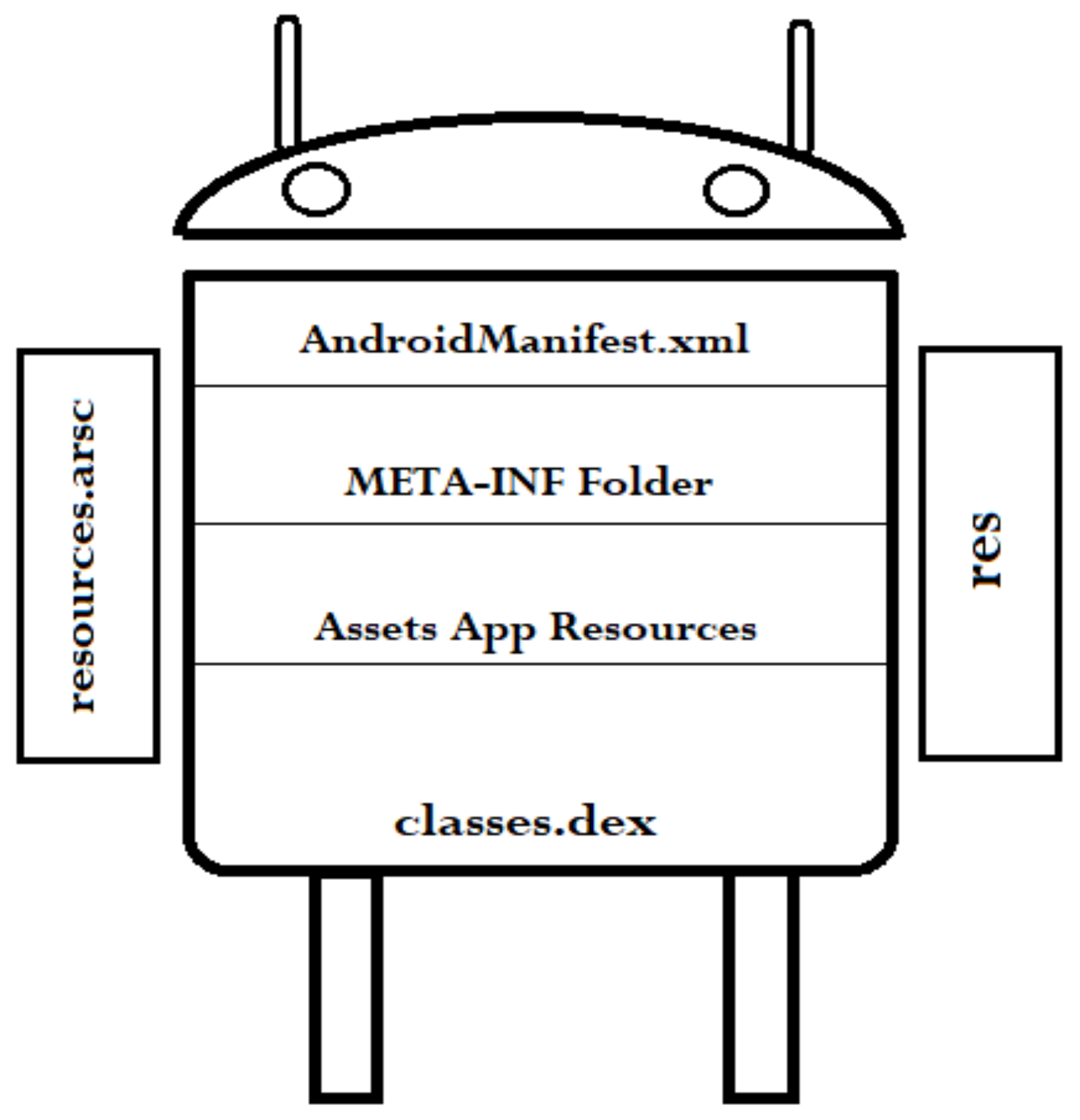

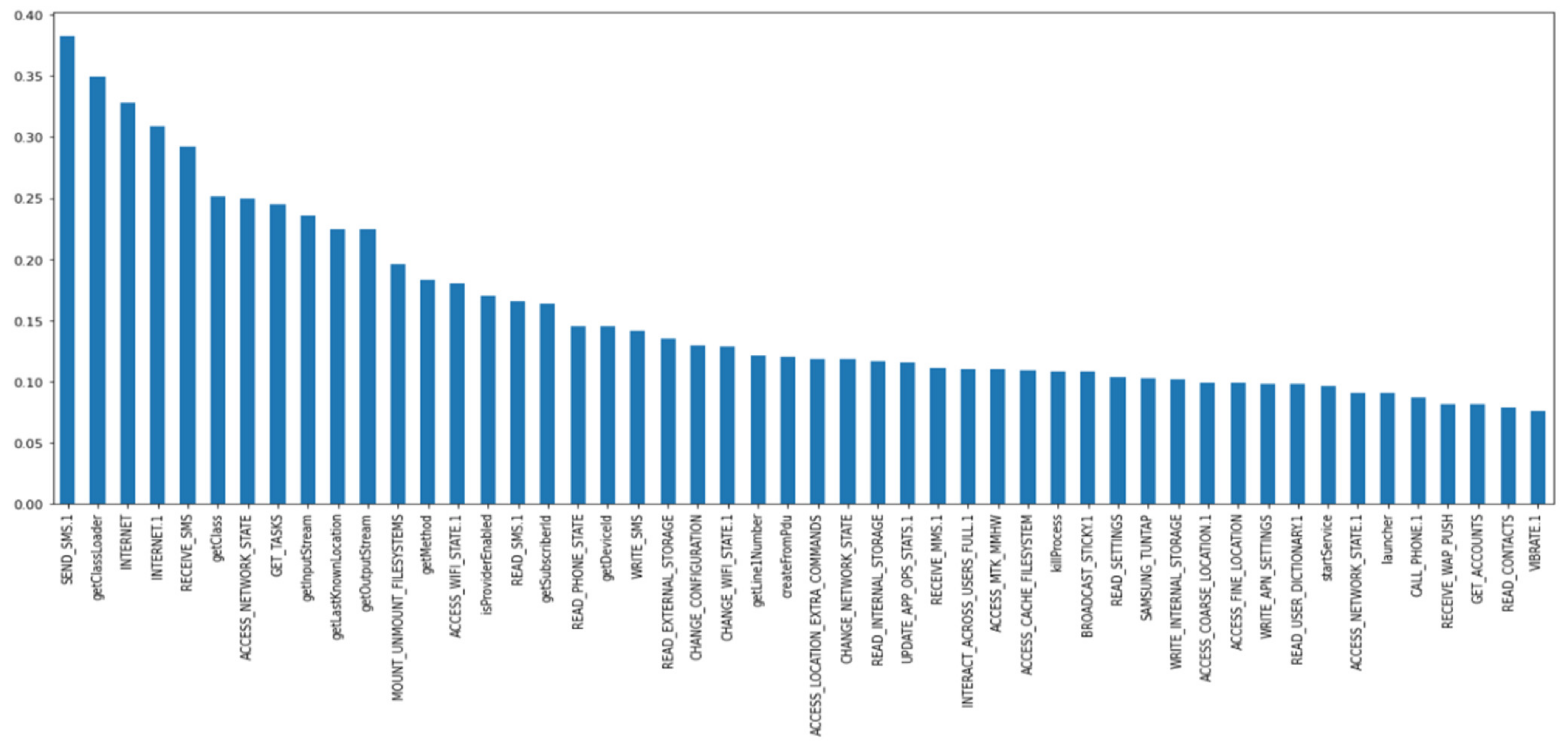
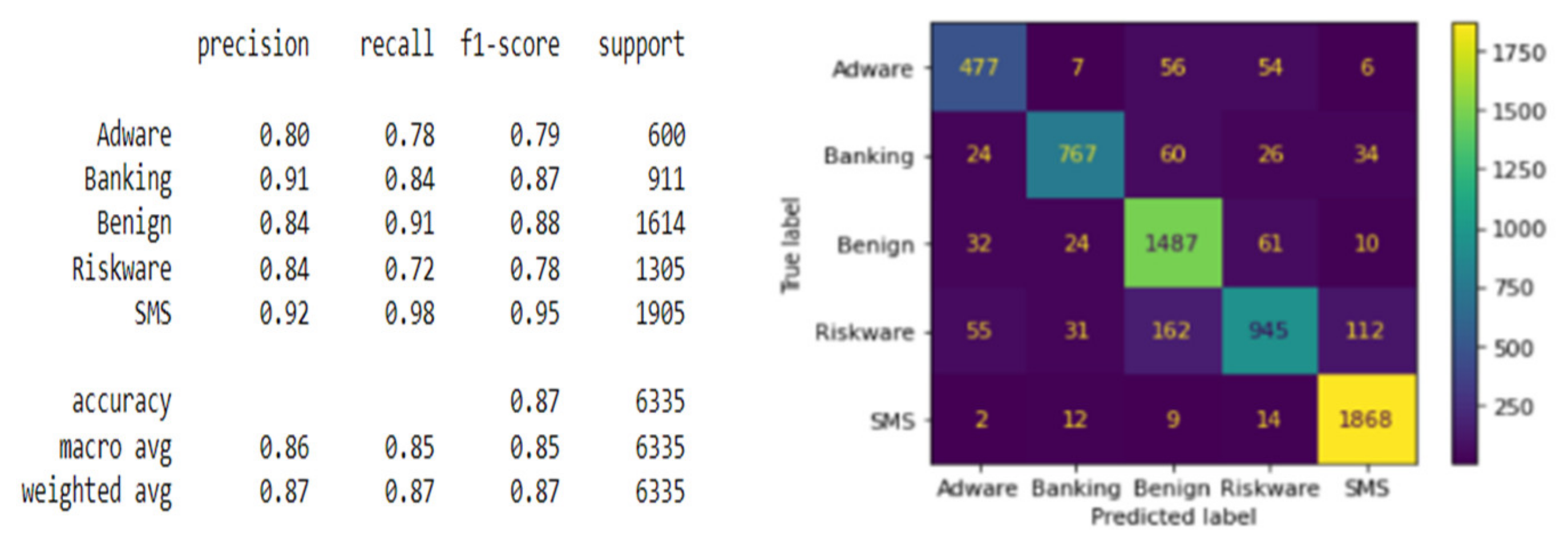



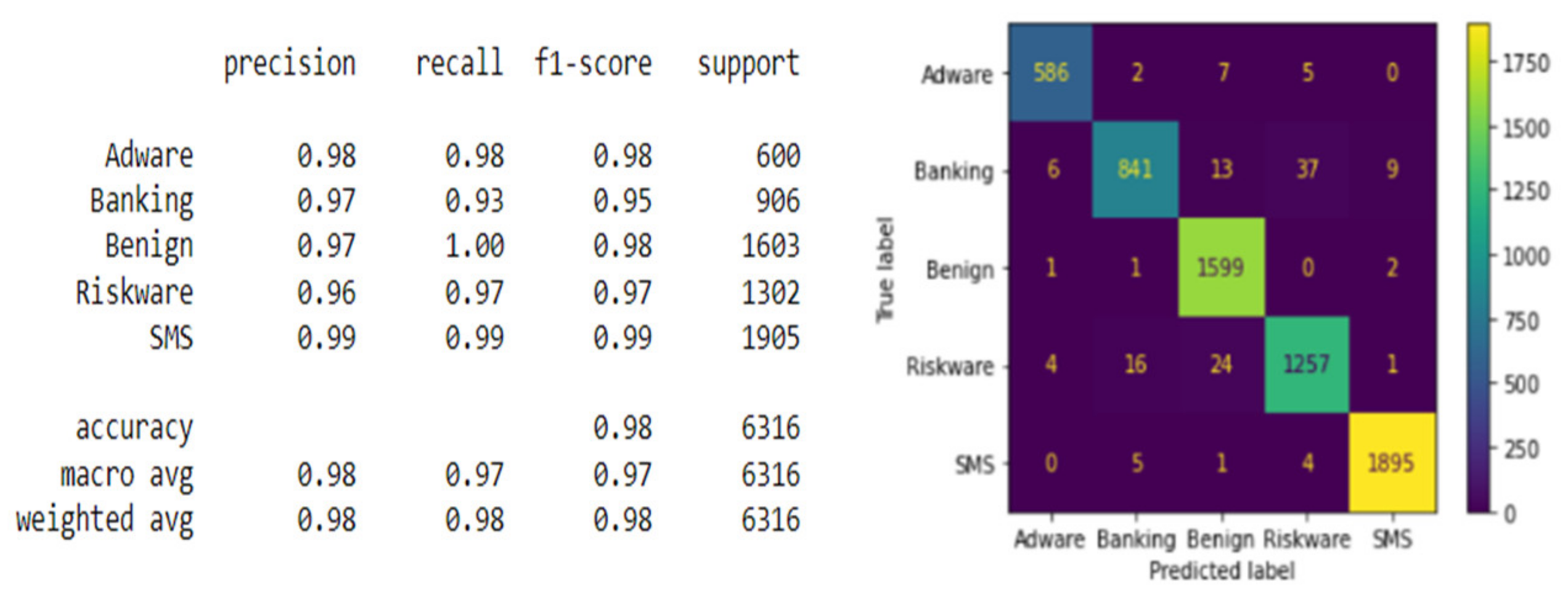

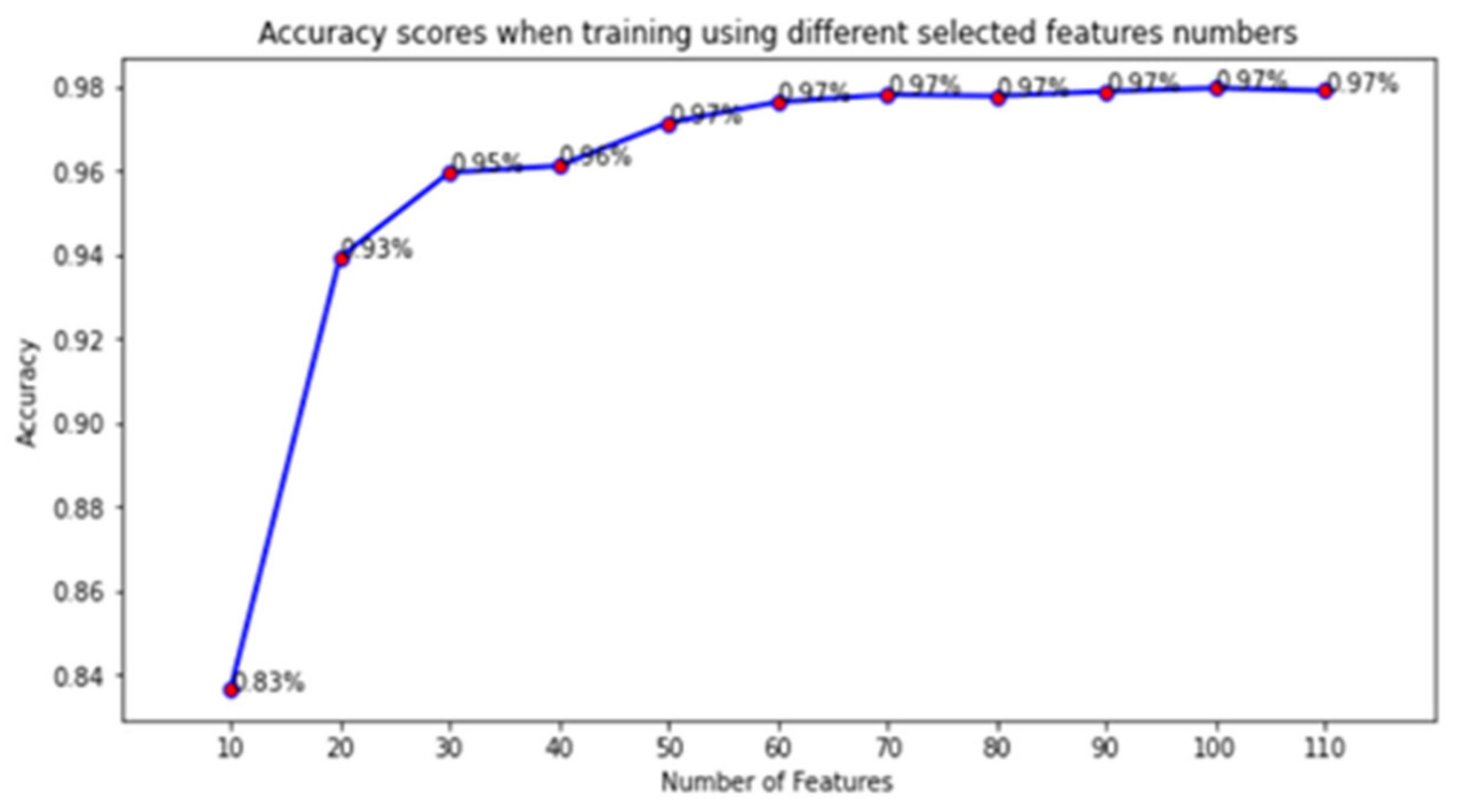
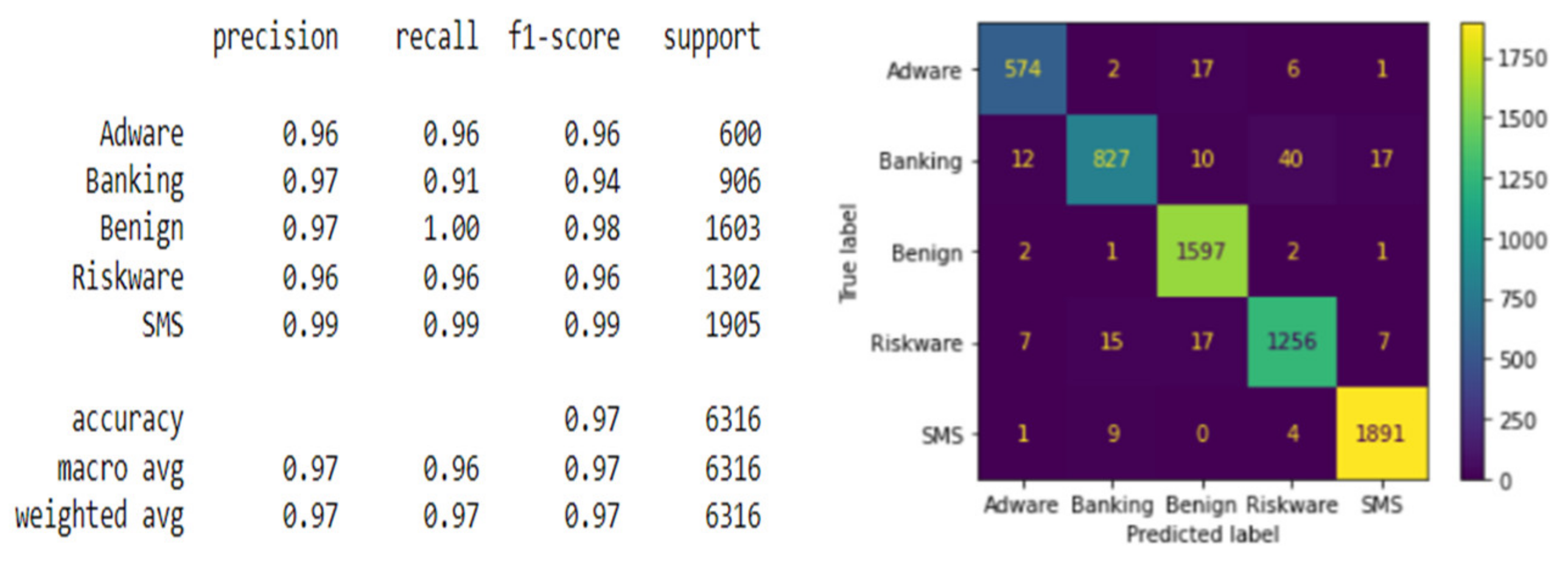
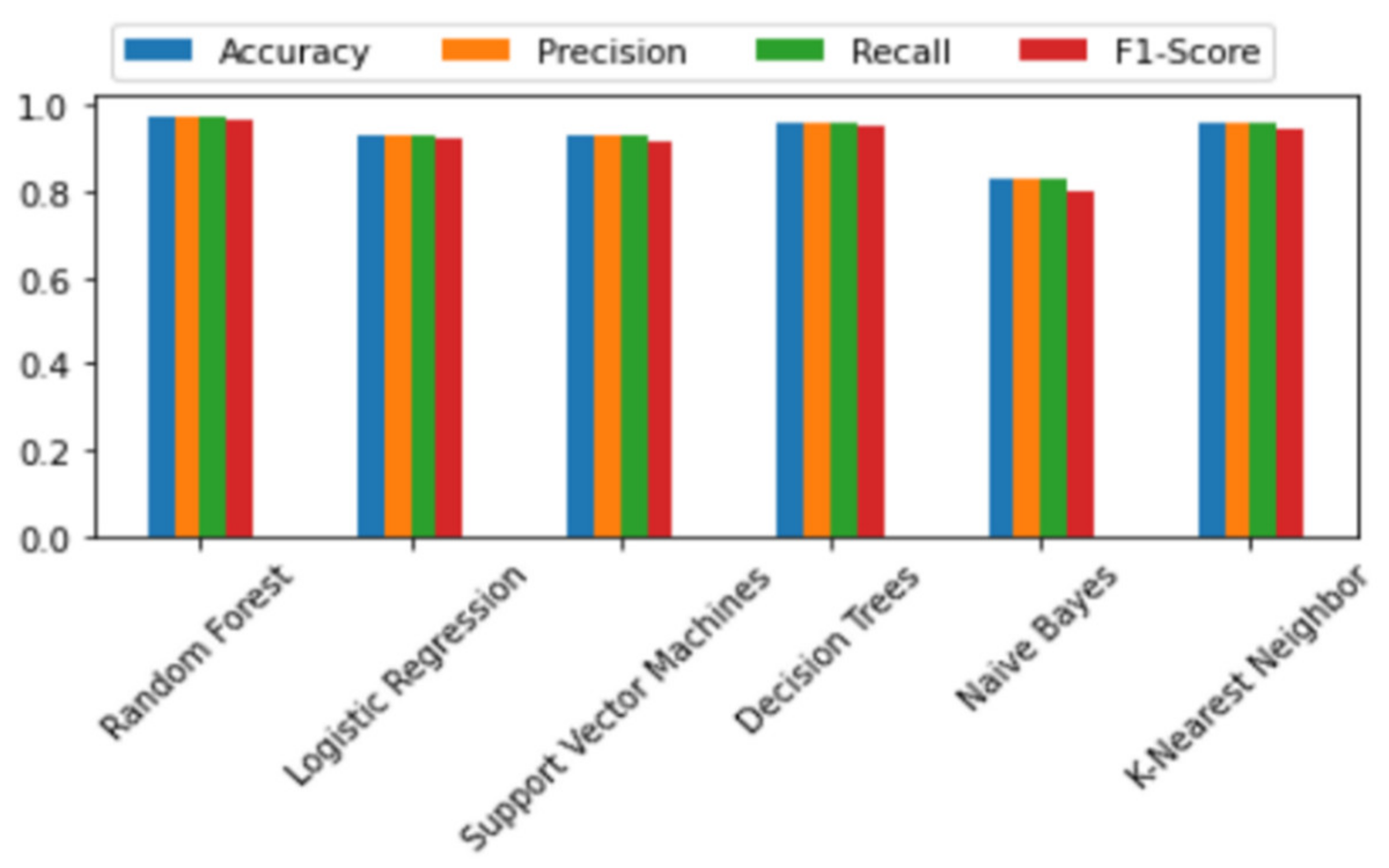

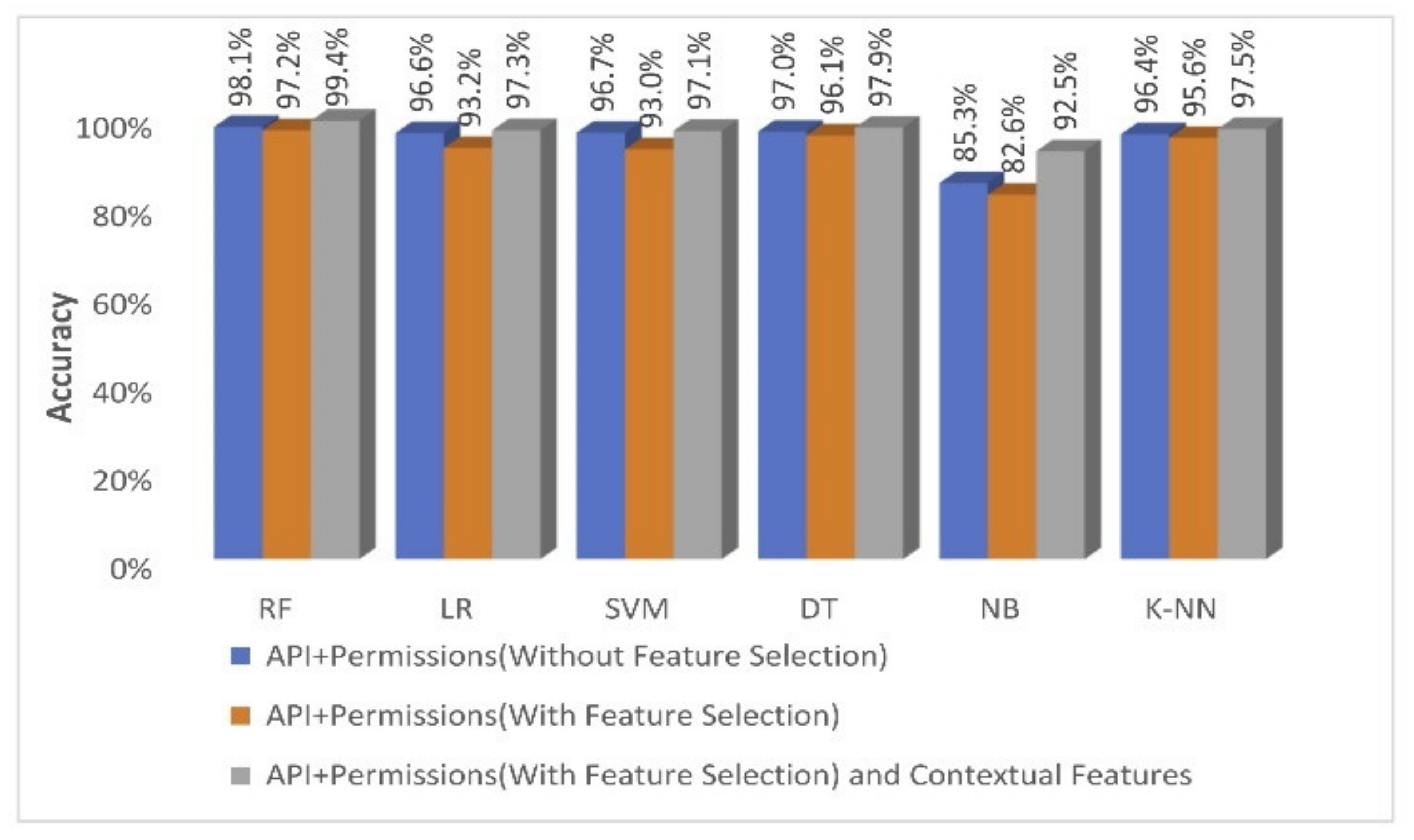

| Mobile Malware | Behavior | Example |
|---|---|---|
| Trojan [5] | Looks to be a harmless application that convinces users to download it and then installs malware on their mobile devices. | Android.Counterlank |
| Worms [6] | Worms can infect additional devices while they are operating on infected systems, and they can carry a payload that degrades mobile network capacity. | Ikee.B |
| Adware [7] | Deceives the user through malicious advertising. | UAPush |
| Spyware [8] | Collects user’s data and behavior, such as email and passwords, and sends it to another location across the network. | Zitmo |
| Botnet [9] | Comprises many internet-connected cellphones controlled by a malicious user; it gains full access to the device and its contents and sends data to the malicious controller. | Not compatible |
| Android Malware Category | Concept |
|---|---|
| Adware | Malware uses advertising to exploit the user. |
| Banking | Malware exploits the banking accounts of the user. |
| SMS | Malware exploits the user by sending a malicious SMS. |
| Riskware | A program that behaves as good but is malware. |
| Application Features Set | Number of Extracted Features |
|---|---|
| API Calls | 15 |
| Permissions | 512 |
| Contextual Information | 4 |
| Total | 531 Features |
| API Calls | Desc. |
|---|---|
| startService | Requests the launch of a specific app service. |
| getDeviceId | Gets the device ID from which an event originated. |
| createFromPdu | Sending an SMS message using the Protocol Data Unit (PDU), which is a cellular data transmission technology. |
| getClassLoader | Returns a class loader that can be used to get classes from a package. |
| getClass | Returns the object’s runtime class. |
| getMethod | Returns a method object that represents the class or interface represented by this class object’s public member method. |
| getDisplayOriginatingAddress | Gives the message’s originating address, or the email address if it was sent through an email gateway. |
| getInputStream | Returns a read-only input stream from any of the open connections. |
| getOutputStream | Returns a write-only output stream to the specified connection. |
| killProcess | The process with the supplied ID will be terminated. |
| getLine1Number | For line 1, this function returns the phone number string. |
| getSimSerialNumber | Gives the SIM serial number. |
| getSubscriberId | Provides the subscriber’s unique ID. |
| getLastKnownLocation | Returns the data from the last known location retrieved from the supplied source. |
| isProviderEnabled | Returns if the given provider is enabled or disabled. |
| Android Application Category | Number of Samples from Which API Call Features Were Extracted |
|---|---|
| Adware | 1499 |
| Banking | 2277 |
| SMS | 4761 |
| Riskware | 3263 |
| Benign | 4036 |
| Total | 15,836 |
| Normal Permission | Desc. |
|---|---|
| ‘android.permission.INTERNET’ | This permission opens network ports for applications. |
| ‘android.permission.ACCESS_WIFI_STATE’ | Permits Wi-Fi network information to be accessed by apps. |
| ‘android.permission.ACCESS_NETWORK_STATE’ | Allows apps to gain access to network information. |
| ‘android.permission.SET_WALLPAPER’ | Allows apps to change the background image. |
| ‘android.permission.SET_TIME_ZONE’ | Allows apps to change the time zone of the phone. |
| Dangerous Permission | Desc. |
|---|---|
| ‘android.permission.READ_CONTACTS’ | Allows apps to access the contact information of the user. |
| ‘android.permission.CAMERA’ | Allows apps to gain access to the phone camera. |
| ‘android.permission.READ_CALL_LOG’ | Allows apps to see the call log of a user. |
| ‘android.permission.SEND_SMS’ | This permission enables apps to send text messages. |
| ‘android.permission.READ_PHONE_STATE’ | Gives apps access to the current state of the phone, such as the device’s phone number, cellular network, and active calls. |
| Android Application Category | Number of Samples from Which Permissions Features Were Extracted |
|---|---|
| Adware | 1499 |
| Banking | 2494 |
| SMS | 4803 |
| Riskware | 3896 |
| Benign | 4011 |
| Total | 16,703 |
| Android Application Contextual Information |
|---|
| num_services |
| num_receivers |
| num_activities |
| num_providers |
| Android Application Category | Number of Samples from Which Contextual Features Were Extracted |
|---|---|
| Adware | 1243 |
| Banking | 1878 |
| SMS | 3908 |
| Riskware | 2498 |
| Benign | 494 |
| Total | 10,021 |
| Android Application (APK) | API Call 1 | API Call 2 | API Call 3 |
|---|---|---|---|
| Application 1 | 1 | 0 | 1 |
| Application 2 | 0 | 0 | 1 |
| Application 3 | 1 | 1 | 1 |
| Android Application (APK) | Permission 1 | Permission 2 | Permission 3 |
|---|---|---|---|
| Application 1 | 1 | 0 | 1 |
| Application 2 | 0 | 0 | 1 |
| Application 3 | 1 | 1 | 1 |
| Accuracy | Precision | Recall | F1-Score | |
|---|---|---|---|---|
| RF | 0.873244 | 0.873244 | 0.873244 | 0.855546 |
| LR | 0.776796 | 0.776796 | 0.776796 | 0.738052 |
| SVM | 0.753118 | 0.753118 | 0.753118 | 0.708540 |
| DT | 0.871665 | 0.871665 | 0.871665 | 0.853826 |
| NB | 0.754854 | 0.754854 | 0.754854 | 0.705594 |
| K-NN | 0.865509 | 0.865509 | 0.865509 | 0.846865 |
| Accuracy | Precision | Recall | F1-Score | |
|---|---|---|---|---|
| RF | 0.973810 | 0.973810 | 0.973810 | 0.971126 |
| LR | 0.953607 | 0.953607 | 0.953607 | 0.950187 |
| SVM | 0.954205 | 0.954205 | 0.954205 | 0.951107 |
| DT | 0.961838 | 0.961838 | 0.961838 | 0.955036 |
| NB | 0.801556 | 0.801556 | 0.801556 | 0.792031 |
| K-NN | 0.955253 | 0.955253 | 0.955253 | 0.949705 |
| Accuracy | Precision | Recall | F1-Score | |
|---|---|---|---|---|
| RF | 0.980526 | 0.980526 | 0.980526 | 0.977692 |
| LR | 0.966276 | 0.966276 | 0.966276 | 0.963571 |
| SVM | 0.967226 | 0.967226 | 0.967226 | 0.964235 |
| DT | 0.969601 | 0.969601 | 0.969601 | 0.965232 |
| NB | 0.852913 | 0.852913 | 0.852913 | 0.841969 |
| K-NN | 0.963743 | 0.963743 | 0.963743 | 0.958180 |
| Accuracy | Precision | Recall | F1-Score | |
|---|---|---|---|---|
| RF | 0.972451 | 0.972451 | 0.972451 | 0.967090 |
| LR | 0.932394 | 0.932394 | 0.932394 | 0.923305 |
| SVM | 0.929544 | 0.929544 | 0.929544 | 0.918958 |
| DT | 0.960735 | 0.960735 | 0.960735 | 0.955430 |
| NB | 0.826314 | 0.826314 | 0.826314 | 0.802296 |
| K-NN | 0.955668 | 0.955668 | 0.955668 | 0.946952 |
| Accuracy | Precision | Recall | F1-Score | |
|---|---|---|---|---|
| RF | 0.994220 | 0.994220 | 0.994220 | 0.991228 |
| LR | 0.972598 | 0.972598 | 0.972598 | 0.971393 |
| SVM | 0.971247 | 0.971247 | 0.971247 | 0.970111 |
| DT | 0.978740 | 0.978740 | 0.978740 | 0.969944 |
| NB | 0.925197 | 0.925197 | 0.925197 | 0.914010 |
| K-NN | 0.975449 | 0.975449 | 0.975449 | 0.958354 |
| Work | Year | Dataset | Features | Number of Features | Methods | Accuracy |
|---|---|---|---|---|---|---|
| [35] | 2022 | Modified ICC-Bench dataset [61] Drebin [24] | Network flow semantics, such as flow contexts and inter-component communication | NA | Natural language processing and deep learning approaches | 95.4% |
| [37] | 2020 | CICMalDroid2020 [39] | System calls, binders, and composite behaviors | 470 | Deep neural networks | 97.84% |
| [38] | 2020 | Drebin [24] Malgenome [63] CICMALDROID2020 [39] | Static (permissions, API Calls, intent, command signatures, and binaries) Dynamic (system calls, binder calls, and composite behaviors) | 261 | SVM, KNN, MLP, RF DT, and Naïve Bayes XGBOOST | 96% |
| [36] | 2018 | DREBIN [24] Virusshare [19] | contextual information (contextual subgraph features) | NA | Multiple lernel learning | 97% |
| The proposed work | 2022 | CICMalDroid2020 [39] | API Calls, permissions, and contextual features | 54 | Random Forest | 99.4% |
Publisher’s Note: MDPI stays neutral with regard to jurisdictional claims in published maps and institutional affiliations. |
© 2022 by the authors. Licensee MDPI, Basel, Switzerland. This article is an open access article distributed under the terms and conditions of the Creative Commons Attribution (CC BY) license (https://creativecommons.org/licenses/by/4.0/).
Share and Cite
AlJarrah, M.N.; Yaseen, Q.M.; Mustafa, A.M. A Context-Aware Android Malware Detection Approach Using Machine Learning. Information 2022, 13, 563. https://doi.org/10.3390/info13120563
AlJarrah MN, Yaseen QM, Mustafa AM. A Context-Aware Android Malware Detection Approach Using Machine Learning. Information. 2022; 13(12):563. https://doi.org/10.3390/info13120563
Chicago/Turabian StyleAlJarrah, Mohammed N., Qussai M. Yaseen, and Ahmad M. Mustafa. 2022. "A Context-Aware Android Malware Detection Approach Using Machine Learning" Information 13, no. 12: 563. https://doi.org/10.3390/info13120563
APA StyleAlJarrah, M. N., Yaseen, Q. M., & Mustafa, A. M. (2022). A Context-Aware Android Malware Detection Approach Using Machine Learning. Information, 13(12), 563. https://doi.org/10.3390/info13120563






